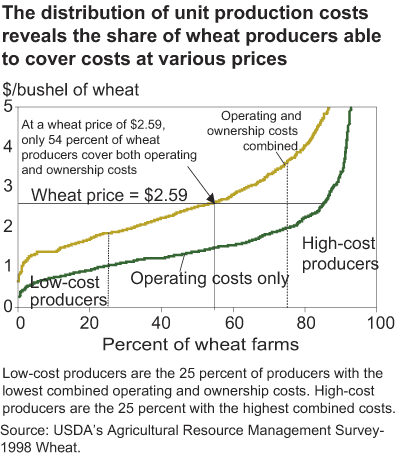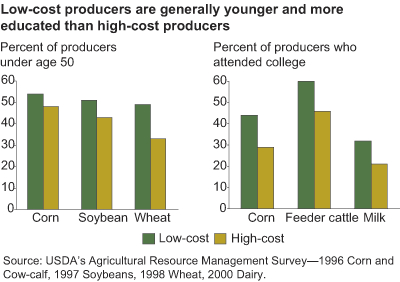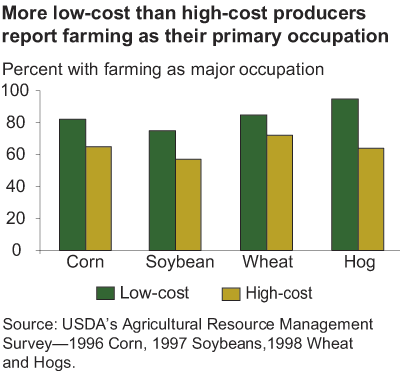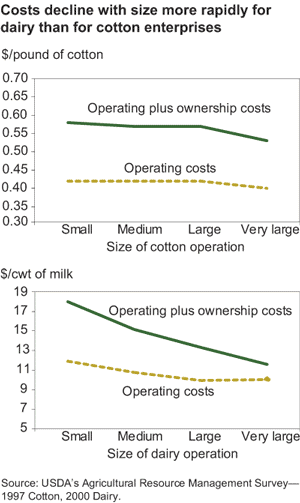Production Costs Critical to Farming Decisions
- by William D. McBride
- 9/1/2003
Policymakers and producers grow nervous when commodity prices dip, as they did during 1998-2001. Weather, breeding cycles, world stocks, and consumption swings can all make for uncertain farm income, and a surefire buffer against fluctuations is impossible. However, farmers make a host of decisions that can predispose them to weathering out rough patches. Farmers make daily decisions about input use, seasonal decisions about what to plant, annual decisions about farmland rental, and multi-year decisions about ownership and upkeep of land, machinery, and facilities. Farmers’ decisions affect agricultural production, prices, and costs; the quality of the environment; the demographics of rural areas; and more. Farmers’ decisions, in turn, are affected by how production costs compare with expected returns and nonmonetary benefits (such as a rural lifestyle) and by the characteristics of the farm (such as type, size, specialization, and location) and farm operator (age, education, and off-farm employment).
Analysts can evaluate such decisions to identify perennially high-cost and low-cost producers and thereby anticipate industry trends. Based on information from the annual Agricultural Resource Management Survey (ARMS), this article examines the extent to which U.S. producers are covering costs and why costs vary among farms.
Are Producers Covering Costs?
Short-term production decisions are mostly based on the relationship between operating costs and expected product prices. Producers have already incurred the cost of owning farm assets, and so give asset cost little consideration. However, as the planning period stretches to 5-10, or even to 20 years and capital assets have to be replaced, producers consider both operating and asset ownership costs in relation to expected prices (see “Enterprise Production Costs”). Replacement of farm assets requires substantial investments, so farmers often make that decision in conjunction with determining whether to continue with a commodity or with farming altogether. Low-cost producers are generally better able to survive periods of low prices and thrive when prices improve, while high-cost producers are often the first to exit farming when prices are low.
While production costs can be used as an indicator of the financial success of farm enterprises, they are not the complete story. Commodity prices and revenue from all sources—commodity sales, contracts in futures markets, production contract fees, insurance indemnity payments, and government program payments—are needed to put the costs into perspective. All of these sources can contribute to the price producers effectively use as the basis for production decisions.
Arranging farms by production costs per unit shows how many producers of a given commodity are able to cover costs at various prices. For example, at $2.59 per bushel of wheat (the average price 1998-2001), most wheat-producing farms (85 percent) covered operating costs. Similarly, most producers of corn (82 percent) and soybeans (96 percent) also covered operating costs, despite low crop prices, during 1998-2001. This helps to explain why most producers continued to produce wheat, corn, and soybeans despite the relatively low prices.
However, when asset ownership costs are factored in, the picture changes. Nearly half of U.S. corn and wheat producers and one-fourth of soybean producers were unable to cover both operating and ownership costs at average commodity prices during 1998-2001. Because corn, soybean, and wheat producers use machinery that is mostly interchangeable among crops, some producers responded to the low prices by changing their crop mix. Also, this cost-price squeeze has put an emphasis on enhancing revenues through a variety of sources, such as government programs, and on controlling or cutting costs. Government program support has likely helped many producers remain in business and may explain why structural adjustments in these industries have been gradual. Improved prices for most crops in 2002-03 have also eased the financial pressure on many high-cost producers.
Hog and milk producers have faced even more divergent prices and costs in recent years. While 13 percent of milk producers and 41 percent of hog producers were unable to cover operating costs between 1998 and 2001, more than half of milk producers and nearly three-fourths of hog producers were unable to cover both operating and asset ownership costs. Not surprisingly, many producers exited these industries and continue to do so as farm milk prices (under $12 per hundredweight) and hog prices (below $40 per hundredweight) remain low.
The distribution of operating and ownership costs also reveals differences between low- and high-cost producers. Low-cost producers, representing the 25 percent of wheat farms with the lowest total costs, produced wheat at $1.86 per bushel or less in 1998. In contrast, high-cost producers, representing the 25 percent of wheat farms with the highest costs, produced wheat at $3.62 per bushel or more. Differences in the characteristics of low- and high-cost producers and their farming operations provide insight into why costs vary among farms and indicate factors that may influence financial success.
How Do Low- and High-Cost Producers Differ?
ARMS data indicate that low-cost producers are generally younger and more educated than high-cost producers. For example, more low-cost producers of corn, soybeans, and wheat are under 50 years of age than are high-cost producers of these crops. Likewise, low-cost producers of corn, feeder cattle, and milk are more likely to have attended college than are high-cost producers. Research has indicated that younger and more educated producers are more likely to adopt production practices and technologies that may reduce unit costs and enhance farm productivity.
Over half of U.S. farm operators work off the farm, and only about 40 percent of farm operators consider farming their primary occupation. Low-cost production of farm commodities is more often associated with farmers whose major occupation is farming. For example, 94 percent of low-cost hog producers report their primary occupation as farming, versus just 63 percent of high-cost producers. Producers dependent on farming as their primary income source likely have different goals and expectations from farming and may place more importance on controlling costs. In contrast, producers primarily retired or part time have a shorter planning horizon and are more likely to use facilities and equipment closer to the end of their useful life and at less than full capacity, which contributes to higher costs.
Only on cow-calf operations were the production costs of retirement and residential farms competitive with those of full-time (occupational) farms. These cow-calf operations tend to use fewer inputs and stock fewer cattle than do other operations. Many retirement and residential farms raise cattle because of the low labor and management required, using acreage that would otherwise be idle.
Cost advantages for certain commodities also accrue to regions due to more productive climate or soils. For example, low-cost producers of corn and soybeans are more often located in Corn Belt States where high-quality soils produce higher yields than in the Southeast, and where ample rainfall reduces costs relative to irrigated crops in the Great Plains. Low-cost cattle producers are more often located in Southern and Western States with a milder climate that reduces cattle feeding costs during the winter. However, technological and organizational advances in hog and milk production have offset much of the cost advantage enjoyed by traditional production areas. As a result, hog and milk production is growing more dispersed.
Size Matters, Particularly for Livestock Operations
Operating costs (per unit) may be lower on larger farms because of their ability to negotiate volume discounts on inputs, better management, and other factors. Asset ownership costs may also be less because capital items—such as machinery, buildings, and equipment—are spread over more units of production.
Cost-size relationships differ among commodities. Unit costs generally decline as size increases, but the rate of decline is much greater for livestock than for crop enterprises. For example, total operating and ownership costs average about 10 percent lower on very large cotton farms than on the small farms, but over 30 percent lower on very large versus small dairy farms. This difference is mainly due to asset ownership costs on large hog and dairy farms that are 60 percent less than those on the smallest farms. Unit costs for the highly specialized facilities and equipment used in livestock production fall rapidly as production increases and these fixed costs are spread over more units.
The influence of size on production costs is also evident in that low-cost operations tend to be larger than high-cost operations. Low-cost corn producers averaged 206 corn acres in 1996, compared with 134 acres for high-cost producers. Low-cost soybean producers averaged 281 acres in 1997, versus 161 acres for high-cost producers. This difference was even more pronounced among hog and cattle producers. Low-cost farrow-to-finish hog producers sold 2,180 head, on average, per farm in 1998, compared with 370 for high-cost producers. Cow herds on low-cost cow-calf operations averaged 144 head in 1996, compared with only 35 head on high-cost operations.
Farm size has been increasing in the U.S., and this trend has been accompanied by greater specialization in production. Greater specialization is depicted by a higher average share of farm production derived from a single commodity. The relationship between costs and specialization has been most apparent among livestock producers. Low-cost hog and cattle producers were more specialized, on average, than were high-cost producers of these commodities, generating more than 50 percent of the value of farm production from these commodities (compared with less than 30 percent on high-cost operations). This relationship was not as strong for cotton producers and was hardly apparent for corn, soybean, and wheat producers. The agronomic benefits of crop rotations may offset cost advantages of specialization, plus most machinery investment on crop farms can be spread over several different crops. The greater average specialization of low-cost cotton farms reflects the need to spread the cost of specialized cotton machinery over more cotton acres.
Management Makes a Difference
Crop and livestock producers possess varying management abilities, and this too affects costs. Although unit costs of hog production decline significantly with size of operation, many well-managed small hog operations rival large operations in production costs.
The managerial ability of farm operators is difficult to quantify by farm and operator characteristics. However, management practices provide a clue. Low-cost crop and livestock producers used practices that enhance input productivity (such as crop rotation) more often than did the high-cost producers. No-till and reduced-tillage practices—which reduce fuel and capital requirements—were used more often by low-cost than by high-cost producers of corn, soybeans, and wheat.
Low-cost livestock producers also tend to manage their operations more efficiently than high-cost producers. The production facilities on low-cost hog and dairy operations were operated much closer to capacity than on high-cost operations. The managerial skills of low-cost hog producers resulted in more pigs weaned per litter. Low-cost milk producers more often favored innovative technologies, such as automated milking facilities and supplemental (milk stimulating) hormones, to achieve higher production with fewer inputs.
Premium on Cost Control
The recent economic pinch encountered by the farm sector has put a premium on cost control among crop and livestock producers. Prices for many field crops have been low relative to the “boom” years of 1996 and 1997, although recently prices have increased. Livestock prices have been highly variable, with hog and milk prices near historic lows at times. To make matters worse, increased energy prices have caused spikes in fuel and fertilizer costs. Also, some farms may have to absorb the costs of complying with increased environmental regulation, such as new rules limiting the amount of manure nutrients that large livestock operations can apply to land.
In response to this cost-price squeeze, many producers will attempt to maintain profitable operations by trying to control costs. Others may opt out. Policymakers have been concerned about what this cost-price squeeze means for the future of family farms and the structure of the farm sector in this newly volatile setting. ARMS data indicate that, at recent commodity prices, nearly half of corn producers and up to three-fourths of hog producers are caught in this cost-price squeeze. If large numbers of these operations go out of business and their production is mostly taken over by other existing firms (as opposed to new entrants), concentration of production in the hands of fewer producers would further increase.
This article is drawn from:
- Short, S.D. (2004). Characteristics and Production Costs of U.S. Dairy Operations. U.S. Department of Agriculture, Economic Research Service. SB-974-6.
- McBride, W.D. & Key, N. (2003). Economic and Structural Relationships in U.S. Hog Production. U.S. Department of Agriculture, Economic Research Service. AER-818.





